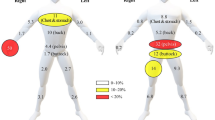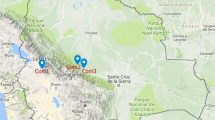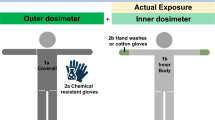Abstract
This paper reports the results of a field study of occupational pesticide exposure (respiratory and dermal) among a group of Italian agricultural subcontractors. These workers consistently use pesticides during much of the year, thus resulting in a high exposure risk. Ten complete treatments were monitored during spring/summer. Pesticides that were applied included azinphos-methyl, dicamba, dimethoate, terbuthylazine, and alachlor. Several observations were made on worker operative modalities and the use of personal protective equipment (PPE) during work. Total potential and actual exposure ranged from 14 to 5700 μg and from 0.04 to 4600 μg, respectively. Dermal exposure contributed substantially more than inhalation to the total exposure (93.9–100%). Hand contamination ranged from 0.04 to 4600 μg and was the major contributor to dermal exposure. Penetration through specific protective garments was less than 2.4% in all cases, although penetration through general work clothing was as high as 26.8%. The risk evaluation, based on comparison between acceptable daily intake and total absorbed doses, demonstrates that it is presumable to expect possible health effects for workers regularly operating without PPE and improper tractors. Comparisons between exposure levels and operative modalities highlighted that complete PPE and properly equipped tractors contributed to a significant reduction in total exposure to pesticides during agricultural activities. In conclusion, monitored agricultural subcontractors presented very different levels of pesticide exposure due to the high variability of operative modalities and use of PPE. These results indicate the need to critically evaluate the efficacy of training programs required for obtaining a pesticide license in Italy.

Similar content being viewed by others
References
Aprea C, Terenzoni B, De Angelis V et al (2004) Evaluation of skin and respiratory doses and urinary excretion of alkylphosphates in workers exposed to dimethoate during treatment of olive trees. Arch Environ Contam Toxicol 48:127–134. doi:10.1007/s00244-004-0073-5
Aprea C, Centi L, Santini S, Lunghini L, Banchi B, Sciarra G (2005) Exposure to omethoate during stapling of ornamental plants in intensive cultivation tunnels: influence of environmental conditions on absorption of the pesticide. Arch Environ Contam Toxicol 49:577–588. doi:10.1007/s00244-005-8025-2
Baldi I, Lebailly P, Jean S, Rougetet L, Dulaurent S, Marquet P (2006) Pesticide contamination of workers in vineyards in France. J Expo Sci Environ Epidemiol 16:115–124. doi:10.1038/sj.jea.7500443
Blair A, Sandler DP, Tarone R et al (2005) Mortality among participants in the Agricultural Health Study. Ann Epidemiol 15:279–285. doi:10.1016/j.annepidem.2004.08.008
Decree of the President of Italian Republic No. 290, April 23 (2001) Regolamento di semplificazione dei procedimenti di autorizzazione alla produzione, alla immissione in commercio e alla vendita di prodotti fitosanitari e relativi coadiuvanti (n. 46, allegato 1, legge n. 59/1997). Supplemento ordinario della Gazzetta Ufficiale della Repubblica Italiana, n. 165 del 18 Luglio
Duhram WF, Wolfe HR (1962) Measurement of the exposure of workers to pesticides. Bull WHO 26:75–91
EUROPOEM I (1996) The development, maintenance and dissemination of a European Predictive Operator Exposure Model (EUROPOEM) database. A EUROPOEM I database and harmonised model. AIR3 CT93-1370. TNO-BIBRA International, Carshalton
EUROPOEM II (2003) The development, maintenance and dissemination of a European Predictive Operator Exposure Model (EUROPOEM II) database. A EUROPOEM II database and harmonised model. FAIR3 CT96-1406. TNO-BIBRA International, Carshalton
Fenske RA, Hamburger SJ (1987) Occupational exposure to fosetyl-Al fungicide during spraying of ornamentals in greenhouses. Arch Environ Contam Toxicol 16:615–621. doi:10.1007/BF01055818
Fenske RA, Blacker AM, Hamburger SJ, Simon GS (1990) Worker exposure and protective clothing performance during manual seed treatment with lindane. Arch Environ Contam Toxicol 19:190–196. doi:10.1007/BF01056086
Flack S, Goktepe I, Ball LM, Nylander-French LA (2008) Development and application of quantitative methods for monitoring dermal and inhalation exposure to propiconazole. J Environ Monit 10:336–344. doi:10.1039/b714882h
Geer LA, Cardello N, Dellarco MJ et al (2004) Comparative analysis of passive dosimetry and biomonitoring for assessing chlorpyrifos exposure in pesticide workers. Ann Occup Hyg 48:683–695. doi:10.1093/annhyg/meh056
Guidotti M, Giovinazzo R, Cedrone O, Vitali M (2000) Determination of organic micropollutants in rain water for laboratory screening of air quality in urban environment. Environ Int 26:23–28. doi:10.1016/S0160-4120(00)00074-X
Gustin CA, Moran SJ, Fuhrman JD et al (2005) Applicator exposure to acetochlor based on biomonitoring. Regul Toxicol Pharmacol 43:141–149. doi:10.1016/j.yrtph.2005.06.015
Hartwell WV, Hayes GR (1965) Respiratory exposure to organic phosphorus insecticides. Observations on effectiveness of respiratory protection in preventing poisoning from occupational exposure to parathion and 2-carbomethoxy-1-methylvinyldimethyl phosphate. Arch Environ Health 11:564–568
ISTAT (2007) Annuario Statistico Italiano 2007. National Institute of Statistics, Rome
Lonsway JA, Byers ME, Dowla HA, Panemangalore M, Antonious GF (1997) Dermal and respiratory exposure of mixers/sprayers to acephate, methamidophos, and endosulfan during tobacco production. Bull Environ Contam Toxicol 59:179–186. doi:10.1007/s001289900462
Maroni M, Fait A, Colosio C (1999) Risk assessment and management of occupational exposure to pesticides. Toxicol Lett 107:145–153. doi:10.1016/S0378-4274(99)00041-7
Marquart J, Brouwer DH, Gijsbers JHJ, Links IHM, Warren N, van Hemmen JJ (2003) Determinants of dermal exposure relevant for exposure modelling in regulatory risk assessment. Ann Occup Hyg 47:599–607. doi:10.1093/annhyg/meg096
Marquart J, Warren ND, Laitinen J, van Hemmen JJ (2006) Default values for assessment of potential dermal exposure of the hands to industrial chemicals in the scope of regulatory risk assessment. Ann Occup Hyg 50:469–489. doi:10.1093/annhyg/mel012
Nicol AM, Kennedy SM (2008) Assessment of pesticide exposure control practices among men and women on fruit-growing farms in British Columbia. J Occup Environ Hyg 5:217–226. doi:10.1080/15459620701839846
NIOSH (1994a) Organophosphorus pesticides. Method 5600. Issue 1. In: Eller PM (ed) NIOSH manual of analytical methods, 4th edn. National Institute for Occupational Safety and Healthy, Cincinnati, OH
NIOSH (1994b) Chlorinated and organonitrogen herbicides (hand wash): method 9200. In: Eller PM (ed) NIOSH manual of analytical methods, 4th edn, Suppl 2. National Institute for Occupational Safety and Healthy, Cincinnati, OH
OECD (1997) Guidance document for the conduct of studies of occupational exposure to pesticides during agricultural application. OECD guidelines for the testing of chemicals. Organisation for Economic Co-operation and Development, Paris
Samanic CM, De Roos AJ, Stewart PA, Rajaraman P, Waters MA, Inskip PD (2008) Occupational exposure to pesticides and risk of adult brain tumors. Am J Epidemiol 167:976–985. doi:10.1093/aje/kwm401
UNI EN 141 (2002) Apparecchi per la protezione delle vie respiratorie—Filtri antigas e combinati—Requisiti, prove, marcatura
USEPA (1995) Interim reregistration eligibility decision for terbuthylazine, case no. 2645. U.S. Environmental Protection Agency, Washington, DC
USEPA (1998) Interim reregistration eligibility decision for alachlor, case no. 0063. U.S. Environmental Protection Agency, Washington, DC
USEPA (2001) Interim reregistration eligibility decision for azinphos-methyl, case no. 0235. U.S. Environmental Protection Agency, Washington, DC
USEPA (2002) Memorandum: dimethoate. 2nd Report of the Hazard Identification Assessment Review Committee. U.S. Environmental Protection Agency, Washington, DC
USEPA (2005) Method 527: determination of selected pesticides and flame retardants in drinking water by solid phase extraction and capillary column gas chromatography/ mass spectrometry (GC/MS). U.S. Environmental Protection Agency, Washington, DC
USEPA (2006) Interim reregistration eligibility decision for dicamba and associated salt, case no. 0065. U.S. Environmental Protection Agency, Washington, DC
van Hemmen JJ (1999) Biocides Steering Group on human exposure assessment: a preliminary report. Toxicol Lett 107:95–102. doi:10.1016/S0378-4274(99)00036-3
Vitali M, Guidotti M, Giovinazzo R, Cedrone O (1998) Determination of pesticide residues in wine by SPME and GC/MS for consumer risk assessment. Food Addit Contam 15:280–287
Werner SL, Burkhardt MR, DeRusseau SN (1996) Methods of analysis by the U.S. Geological Survey National Water Quality Laboratory—determination of pesticides in water by Carbopak-B solid-phase extraction and high-performance liquid chromatography. U.S. Geological Survey Open-File Report 96–216
World Health Organization (2005) The WHO recommended classification of pesticides by hazard and guidelines to classification: 2004. World Health Organization, Geneva, Switzerland
Yeung P, Cantrell P, Murdoch C et al (1998) Exposure of air blast applicators to ethyl parathion and methyl parathion in orchards: a comparison of australian conditions to overseas predictive exposure models. Appl Occup Environ Hyg 13:242–251
Author information
Authors and Affiliations
Corresponding author
Rights and permissions
About this article
Cite this article
Vitali, M., Protano, C., Del Monte, A. et al. Operative Modalities and Exposure to Pesticides During Open Field Treatments Among a Group of Agricultural Subcontractors. Arch Environ Contam Toxicol 57, 193–202 (2009). https://doi.org/10.1007/s00244-008-9225-3
Received:
Accepted:
Published:
Issue Date:
DOI: https://doi.org/10.1007/s00244-008-9225-3




